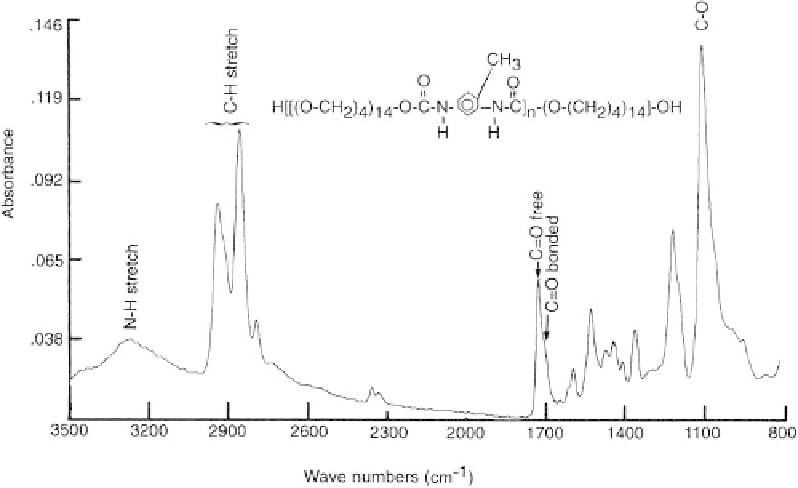Biomedical Engineering Reference
In-Depth Information
interplanar spacings. The interplanar spacings can be used
without further manipulation or the data can be fit to
a model such as a disordered helix or an extended chain.
The crystalline chain conformation and atomic place-
ments can then be accurately inferred.
Small-angle X-ray scattering (SAXS) is used in de-
termining the structure of many multiphase materials.
This technique requires an electron density difference
to be present between two components in the solid
and has been widely applied to morphological studies
of copolymers and ionomers. It can probe features of
10-1000
˚
in size. With appropriate modeling of the
data, SAXS can give detailed structural information
unavailable with other techniques.
Electron microscopy of thin sections of a polymeric
solid can also give direct morphological data on a polymer
of interest, assuming that (1) the polymer possesses
sufficient electron density contrast or can be appro-
priately stained without changing the morphology and
(2) the structures of interest are sufficiently large.
A number of solutions of varying concentrations are
measured, and the data are extrapolated to zero con-
centration to determine
M
w
.
Determination of structure
Infrared (IR) spectroscopy is often used to characterize
the chemical structure of polymers. IR spectra are
obtained by passing IR radiation through the sample of
interest and observing the wavelength of the absorption
peaks. These peaks are caused by the absorption of the
radiation and its conversion into specific motions, such as
C-H stretching. The IR spectrum of a polyurethane is
shown in
Fig. 3.2.2-13
, with a few of the bands of interest
marked.
Nuclear magnetic resonance (NMR), in which the
magnetic spin energy levels of nuclei of spin 1/2 or
greater are probed, may also be used to analyze chemical
composition.
1
H and
13
C NMR are the most frequently
studied isotopes. Polymer chemistry can be determined
in solution or in the solid state.
Figure 3.2.2-14
shows
a
13
C NMR spectrum of a polyurethane with a table
assigning the peaks to specific chemical groups. NMR is
also used in a number of more specialized applications
relating to local motions and intermolecular interactions
of polymers.
Wide-angle X-ray scattering (WAXS) techniques are
useful for probing the local structure of a semicrystalline
polymeric solid. Under appropriate conditions, crystal-
line materials diffract X-rays, giving rise to spots or rings.
According to Bragg's law, these can be interpreted as
Mechanical and thermal property studies
In stress-strain or tensile testing, a dog-bone-shaped
polymer sample is subjected to a constant elongation, or
strain, rate, and the force required to maintain the con-
stant elongation rate is monitored. As discussed earlier,
tensile testing gives information about modulus, yield
point, and ultimate strength of the sample of interest.
Dynamic mechanical analysis (DMA) provides in-
formation
about
the
small
deformation
behavior
of
Fig. 3.2.2-13 IR spectrum of a poly(tetramethylene oxide)/toluene diisocyanate-based polyurethane.






